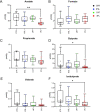Human milk oligosaccharides induce acute yet reversible compositional changes in the gut microbiota of conventional mice linked to a reduction of butyrate levels
- PMID: 37223362
- PMCID: PMC10117735
- DOI: 10.1093/femsml/uqac006
Human milk oligosaccharides induce acute yet reversible compositional changes in the gut microbiota of conventional mice linked to a reduction of butyrate levels
Abstract
Human Milk Oligosaccharides (HMOs) are glycans with prebiotic properties known to drive microbial selection in the infant gut, which in turn influences immune development and future health. Bifidobacteria are specialized in HMO degradation and frequently dominate the gut microbiota of breastfed infants. However, some species of Bacteroidaceae also degrade HMOs, which may prompt selection also of these species in the gut microbiota. To investigate to what extent specific HMOs affect the abundance of naturally occurring Bacteroidaceae species in a complex mammalian gut environment, we conducted a study in 40 female NMRI mice administered three structurally different HMOs, namely 6'sialyllactose (6'SL, n = 8), 3-fucosyllactose (3FL, n = 16), and Lacto-N-Tetraose (LNT, n = 8), through drinking water (5%). Compared to a control group receiving unsupplemented drinking water (n = 8), supplementation with each of the HMOs significantly increased both the absolute and relative abundance of Bacteroidaceae species in faecal samples and affected the overall microbial composition analyzed by 16s rRNA amplicon sequencing. The compositional differences were mainly attributed to an increase in the relative abundance of the genus Phocaeicola (formerly Bacteroides) and a concomitant decrease of the genus Lacrimispora (formerly Clostridium XIVa cluster). During a 1-week washout period performed specifically for the 3FL group, this effect was reversed. Short-chain fatty acid analysis of faecal water revealed a decrease in acetate, butyrate and isobutyrate levels in animals supplemented with 3FL, which may reflect the observed decrease in the Lacrimispora genus. This study highlights HMO-driven Bacteroidaceae selection in the gut environment, which may cause a reduction of butyrate-producing clostridia.
Keywords: HMO; bacteroides; butyrate; microbiome; microbiota; prebiotic.
© The Author(s) 2022. Published by Oxford University Press on behalf of FEMS.
Conflict of interest statement
Harshitha Jois is employed as a PhD student at the company Glycom/DSM, which produces and sells human milk oligosaccharides. All other authors declare that they have no competing financial interests.
Figures







References
-
- Altschul SF, Gish W, Miller Wet al. Basic local alignment search tool. J Mol Biol. 1990;215:403–10. - PubMed
-
- Bäckhed F, Roswall J, Peng Yet al. Dynamics and stabilization of the human gut microbiome during the first year of life. Cell Host Microbe. 2015;17:690–703. - PubMed
-
- Bode L. The functional biology of human milk oligosaccharides. Early Hum Dev. 2015;91:619–22. - PubMed
LinkOut - more resources
Full Text Sources
